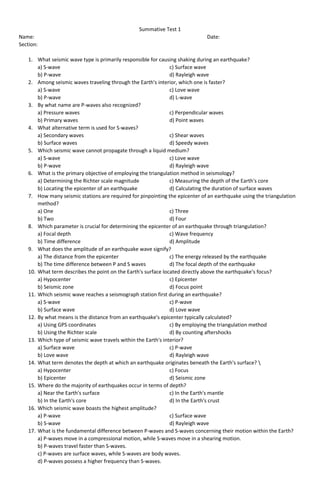
Summattive test 1.docx
- 1. Summative Test 1 Name: Date: Section: 1. What seismic wave type is primarily responsible for causing shaking during an earthquake? a) S-wave b) P-wave c) Surface wave d) Rayleigh wave 2. Among seismic waves traveling through the Earth's interior, which one is faster? a) S-wave b) P-wave c) Love wave d) L-wave 3. By what name are P-waves also recognized? a) Pressure waves b) Primary waves c) Perpendicular waves d) Point waves 4. What alternative term is used for S-waves? a) Secondary waves b) Surface waves c) Shear waves d) Speedy waves 5. Which seismic wave cannot propagate through a liquid medium? a) S-wave b) P-wave c) Love wave d) Rayleigh wave 6. What is the primary objective of employing the triangulation method in seismology? a) Determining the Richter scale magnitude b) Locating the epicenter of an earthquake c) Measuring the depth of the Earth's core d) Calculating the duration of surface waves 7. How many seismic stations are required for pinpointing the epicenter of an earthquake using the triangulation method? a) One b) Two c) Three d) Four 8. Which parameter is crucial for determining the epicenter of an earthquake through triangulation? a) Focal depth b) Time difference c) Wave frequency d) Amplitude 9. What does the amplitude of an earthquake wave signify? a) The distance from the epicenter b) The time difference between P and S waves c) The energy released by the earthquake d) The focal depth of the earthquake 10. What term describes the point on the Earth's surface located directly above the earthquake's focus? a) Hypocenter b) Seismic zone c) Epicenter d) Focus point 11. Which seismic wave reaches a seismograph station first during an earthquake? a) S-wave b) Surface wave c) P-wave d) Love wave 12. By what means is the distance from an earthquake's epicenter typically calculated? a) Using GPS coordinates b) Using the Richter scale c) By employing the triangulation method d) By counting aftershocks 13. Which type of seismic wave travels within the Earth's interior? a) Surface wave b) Love wave c) P-wave d) Rayleigh wave 14. What term denotes the depth at which an earthquake originates beneath the Earth's surface? a) Hypocenter b) Epicenter c) Focus d) Seismic zone 15. Where do the majority of earthquakes occur in terms of depth? a) Near the Earth's surface b) In the Earth's core c) In the Earth's mantle d) In the Earth's crust 16. Which seismic wave boasts the highest amplitude? a) P-wave b) S-wave c) Surface wave d) Rayleigh wave 17. What is the fundamental difference between P-waves and S-waves concerning their motion within the Earth? a) P-waves move in a compressional motion, while S-waves move in a shearing motion. b) P-waves travel faster than S-waves. c) P-waves are surface waves, while S-waves are body waves. d) P-waves possess a higher frequency than S-waves.
- 2. 18. During an earthquake, which seismic wave type typically reaches a seismograph station first? a) S-wave b) P-wave 19. Which seismic wave type is more likely to cause structural damage to surface buildings? a) S-wave b) P-wave 20. Why is it imperative to use a minimum of three seismic stations when determining the epicenter of an earthquake through triangulation? a) To calculate the Richter scale magnitude b) To account for surface wave interference c) To precisely identify the epicenter 21. How does the amplitude of an earthquake wave relate to the energy it releases? a) A higher amplitude indicates a greater energy release b) A lower amplitude indicates a greater energy release c) Amplitude has no bearing on energy release 22. When an earthquake generates both P-waves and S-waves, which one arrives at a seismograph station first, and why? a) P-wave, because it is faster b) S-wave, because it is faster 23. How do the directions of particle motion differ between P-waves and S-waves? a) P-waves move particles side to side, while S-waves move particles up and down. b) Both P-waves and S-waves move particles side to side. c) Both P-waves and S-waves move particles in a circular motion. 24. In the triangulation method used for determining an earthquake's epicenter, why is it crucial to employ at least three seismograph stations? a) To calculate the Richter scale magnitude b) To minimize the travel time of seismic waves c) To precisely locate the epicenter 25. Which seismic wave type travels faster through the Earth's interior, P-waves, or S-waves? a) P-waves b) S-waves c) They travel at the same speed 26. If three seismograph stations, A, B, and C, record P-wave arrival times of 20 seconds, 15 seconds, and 25 seconds after the earthquake, what is the average P-wave arrival time for triangulation? a) 20 seconds b) 15 seconds c) 25 seconds 27. If the average P-wave arrival time for triangulation is 18 seconds, and the average distance from the epicenter is 160 kilometers, what is the estimated P-wave speed in kilometers per second (km/s)? a) 8.89 km/s b) 9.00 km/s c) 10.00 km/s d) 11.11 km/s 28. If the average S-wave arrival time for triangulation is 45 seconds, and the average P-wave arrival time is 18 seconds, what is the time difference (in seconds) between P-waves and S-waves? a) 27 seconds b) 63 seconds 29. Given a time difference of 27 seconds between P-waves and S-waves, and knowing that the average P-wave speed is 8.89 km/s, what is the estimated distance from the epicenter for triangulation? a) 224.97 kilometers b) 240.03 kilometers c) 191.67 kilometers d) 175.00 kilometers 30. If a P-wave arrives at Seismograph Station A at 8:00 AM and at Station B at 8:03 AM, and the S-wave arrives at Station A at 8:06 AM, what is the time difference between the arrival of the P-wave and S-wave at Station A? a) 3 minutes b) 6 minutes c) 9 minutes “Seek Discomfort; It Fosters Growth”